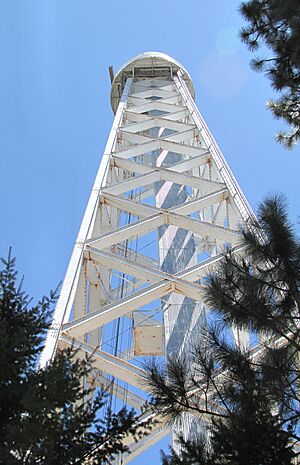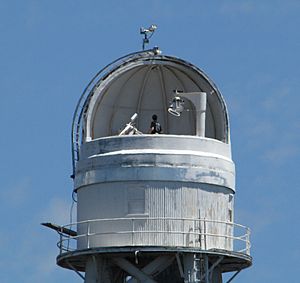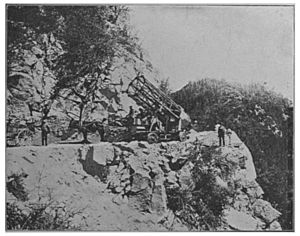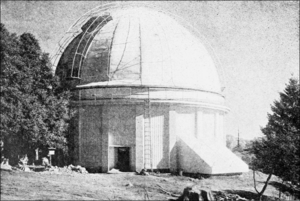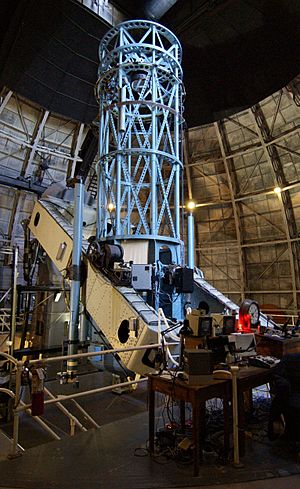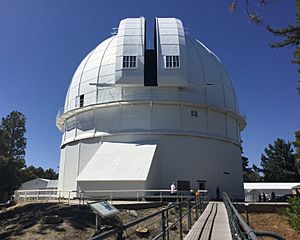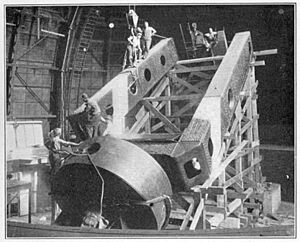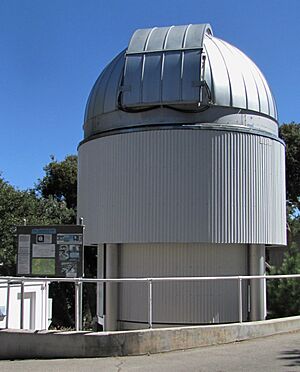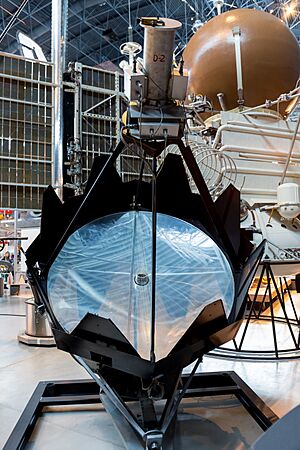Mount Wilson Observatory facts for kids
| Location | Mount Wilson, California, US | ||||||||||
|---|---|---|---|---|---|---|---|---|---|---|---|
Quick facts for kids
|
|||||||||||
The Mount Wilson Observatory (MWO) is a famous place for looking at the stars and space. It's located in Los Angeles County, California, high up on Mount Wilson. This mountain is about 5,710-foot (1,740-meter) tall and is part of the San Gabriel Mountains, not far from Pasadena.
This observatory is home to some very important telescopes. One is the 100-inch (2.5 m) Hooker telescope. It was the biggest telescope in the world from 1917 to 1949! Another is the 60-inch telescope, which was the largest when it was finished in 1908. Mount Wilson also has special telescopes for studying the Sun, like the Snow Solar Telescope and two tall solar towers. Plus, it has the CHARA array, a huge optical interferometer that started working in 2004.
Mount Wilson is a great spot for astronomy because the air is very steady. This is due to a special weather pattern over Los Angeles. Even though city lights make it harder to see faint objects in deep space, the observatory is still very active. The CHARA array, for example, continues to do important research on stars. The observatory was started by George Ellery Hale in 1904 with money from the Carnegie Institution of Washington.
Contents
Solar Telescopes: Studying Our Sun
Mount Wilson Observatory has three special solar telescopes. These telescopes are designed to study our Sun. Today, only one of them, the 60-foot (18 m) Solar Tower, is still used for solar research.
Snow Solar Telescope: The First Solar Scope
The Snow Solar Telescope was the very first telescope set up at Mount Wilson. It was the world's first solar telescope that stayed in one place. Before this, solar telescopes had to be moved around to different places to see solar eclipses. This telescope was given to the Yerkes Observatory by Helen Snow. George Ellery Hale brought it to Mount Wilson to use it for serious science.
It had a 24-inch (61 cm) main mirror. This telescope helped scientists study sunspots and how the Sun spins. It also took daily pictures of the Sun. Today, college students often use the Snow telescope to learn about the Sun and how to analyze light. It was also used for the public to watch Mercury cross the Sun in 2016.
60-foot Solar Tower: Seeing Magnetic Fields
The 60-foot (18 m) Solar Tower was built after the Snow telescope. It was finished in 1908. Its tall design helped scientists get much clearer pictures of the Sun. Being high above the ground meant less blurry views caused by the Sun heating the air.
On June 25, 1908, George Ellery Hale used this tower to discover something amazing. He saw that sunspots have magnetic fields! This was the first time anyone found magnetic fields anywhere other than Earth. Later, scientists also found that the magnetic poles of sunspots switch every solar cycle. In the 1960s, Robert Leighton used this tower to discover that the Sun vibrates every 5 minutes. This led to a new field of study called helioseismology. The University of Southern California now operates this tower.
150-foot Solar Tower: A Giant for Solar Studies
The 150-foot (46 m) Solar Tower is even taller, actually 176 feet (54 m) high. It has a special "tower-in-a-tower" design. An inner tower holds the mirrors, and an outer tower protects them from wind. This design kept the optics very steady. Two mirrors send sunlight down to a 12-inch (30 cm) lens on the ground floor.
This tower was first completed in 1910. It helped scientists study how the Sun rotates and the magnetic fields of sunspots. It was the world's largest solar telescope for 50 years! In 1985, UCLA took over running this important telescope.
60-inch Telescope: A Big Step Forward
The 60-inch (1.5 m) telescope has an interesting story. George Ellery Hale received its large mirror blank as a gift from his father in 1896. This glass disk was 19 cm (7.5 in) thick and weighed 860 kg (1,900 lb)! It took a long time to get funding and grind the mirror, which was finished in 1907.
Moving the telescope parts to the top of Mount Wilson was a huge job. It finally saw "first light" (its first use) on December 8, 1908. At that time, it was the largest working telescope in the world. It was much better than older telescopes because it had a glass mirror and could track objects in the sky very accurately.
This telescope was incredibly successful. It helped scientists learn about the light from stars, measure distances to stars, and take pictures of nebulas (clouds of gas and dust in space). Even after a bigger telescope was built nine years later, the 60-inch remained one of the most important telescopes for many decades.
In 1992, the 60-inch telescope got a new system called "adaptive optics." This system helped it see much clearer by correcting for blurry effects from Earth's atmosphere. Today, this telescope is used for public outreach. It's the second-largest telescope in the world that the general public can use. Groups can book it for an evening to look at the Moon, planets, and other amazing objects in space.
100-inch Hooker Telescope: Changing Our View of the Universe
The 100-inch (2.5 m) Hooker telescope was finished in 1917. It was the biggest telescope in the world until 1949. This telescope is famous because of the amazing discoveries made with it by Edwin Hubble.
Using this telescope in the 1920s, Hubble proved two huge things that changed how we see the universe:
- He showed that the universe is much bigger than our own Milky Way galaxy. He found that many "nebulae" were actually other galaxies, millions of light-years away.
- He then discovered that the universe is actually getting bigger!
Other important discoveries made with the Hooker telescope include:
- In 1923, Edwin Hubble proved the Andromeda nebula was a separate galaxy.
- In 1929, Hubble and Milton Humason confirmed the universe is expanding. They also measured how fast it was growing.
- In the 1930s, Fritz Zwicky found evidence for dark matter, a mysterious substance in space.
- In the 1940s, Walter Baade's work helped us understand different types of stars. This also doubled the known size of the universe.
Building the Hooker Telescope
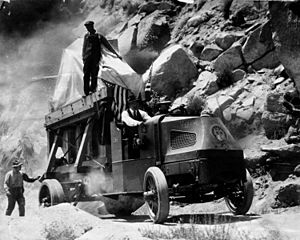
After the 60-inch telescope was underway, Hale immediately wanted an even bigger one. John D. Hooker gave money for the mirror, and Andrew Carnegie helped pay for the rest of the telescope and its dome. The mirror blank was made in 1908. The Hooker telescope finally saw "first light" on November 2, 1917. Like the 60-inch, it used mercury to help support its huge 100 ton[convert: unit invalid here] weight.
In 1919, a special device called an astronomical interferometer was added to the Hooker telescope. It was designed by Albert A. Michelson. This device allowed Michelson to measure the exact size of stars, like Betelgeuse, for the very first time!
In 1935, the mirror's silver coating was changed to aluminum. This new coating reflected 50% more light, making the telescope even more powerful.
Edwin Hubble used the Hooker telescope for many of his key studies. In 1923, he found the first Cepheid variable star in the Andromeda nebula. This helped him figure out how far away Andromeda was and prove it was a galaxy outside our Milky Way. Later, with Milton L. Humason, Hubble observed how light from many galaxies was "redshifted." In 1929, they published a paper showing that the universe is expanding.
The Hooker telescope was the largest for three decades. Its record was broken in 1949 by the 200-inch (5.1 m) Hale Telescope at Palomar Observatory.
By the 1980s, light pollution from Los Angeles made it harder to use the Hooker for deep space research. In 1989, the Carnegie Institution stopped running it. But it was restarted in 1992 and later got new adaptive optics systems. In 2014, the telescope was changed again. It became the world's largest telescope dedicated to public use. Now, people can book it for observing nights, just like the 60-inch telescope.
Interferometry: Seeing Finer Details
Astronomical interferometry is a special way to use multiple telescopes together. It helps astronomers see very fine details, like the actual size of stars. Mount Wilson is perfect for this because its air is so steady.
20-foot Stellar Interferometer: Measuring Star Sizes
In 1919, the 100-inch Hooker telescope got a special attachment: the 20-foot Stellar Interferometer. It was designed by Albert A. Michelson and Francis G. Pease. This device used the Hooker telescope to stay pointed at stars. By December 1920, Michelson and Pease used it to measure the exact diameter of a star, the red giant Betelgeuse. This was the first time anyone had measured the angular size of a star! They measured six more red giant stars the next year.
50-foot Stellar Interferometer: Pushing the Limits
To try and measure even more stars, a 50-foot interferometer was built in 1929. It also successfully measured Betelgeuse. However, it couldn't measure many new stars that the 20-foot one hadn't already found. At that time, technology limited how much more they could do with this method. It took about 30 years for new tools like faster computers and lasers to make bigger interferometers possible again.
Infrared Spatial Interferometer (ISI)
The Infrared Spatial Interferometer (ISI) uses three 1.65-metre (65 in) telescopes. These telescopes work together to act like one giant telescope. They can be moved up to 70 m (230 ft) apart. This gives them the power to see details as small as 0.003 arcseconds. The ISI is run by the University of California, Berkeley.
CHARA Array: Imaging Star Surfaces
The Center for High Angular Resolution Astronomy (CHARA) is another amazing interferometer. It has six 1 m (3.3 ft) telescopes spread out over a maximum distance of 330 m (1,080 ft). Light from these telescopes travels through vacuum pipes and is combined. This allows CHARA to see incredibly fine details, down to 0.0005 arcseconds.
CHARA started scientific work in 2002. In 2007, it captured the first image of the surface of a main sequence star other than our Sun! This array is built and run by Georgia State University.
Other Telescopes at Mount Wilson
In 1966, a 61-centimetre (24 in) telescope with an infrared detector was used by Eric Becklin. He used it to find the center of our Milky Way galaxy for the first time.
Later, in 1968, Gerry Neugebauer and Robert B. Leighton used a 157-centimetre (62 in) reflecting telescope they built. This telescope, called the Caltech Infrared Telescope, was used to map the sky in infrared light. You can now see this historic telescope on display at the Udvar-Hazy Center, which is part of the Smithsonian Air and Space Museum.
Special Events and History
- Letters sent to the Mount Wilson Observatory are part of a special display at the Museum of Jurassic Technology in Los Angeles, California. This exhibit shows unusual letters and ideas sent to the observatory between 1915 and 1935.
- The observatory has faced threats from wildfires. In August 2009, and again in September 2020, flames came very close to the observatory. Firefighters worked hard to protect it. In January 2025, the observatory was evacuated due to the Eaton Fire, which also approached Mount Wilson.
- The famous English poet Alfred Noyes was there when the Hooker telescope first opened on November 2, 1917. He wrote about this night in his poem Watchers of the Sky. He even said he was the first person to see one of Jupiter's moons through the new telescope!
Sunday Afternoon Concerts in the Dome
On one Sunday each month during the warmer parts of the year, Mount Wilson Observatory hosts music concerts. These concerts take place inside the dome of the 100-inch Hooker telescope! The idea started in 2017 when a board member, Dan Kohne, talked with a cellist named Cécilia Tsan. She thought the sound inside the dome was "extraordinary," like famous concert halls around the world.
These concerts help the observatory stay open. Since light pollution makes it hard for the observatory to do much scientific research now, it doesn't get much science funding. The money from these concerts, along with public viewing nights, helps maintain this historic landmark.
See also
 In Spanish: Observatorio del Monte Wilson para niños
In Spanish: Observatorio del Monte Wilson para niños
- List of largest optical reflecting telescopes
- List of observatories
- Mount Wilson Toll Road


